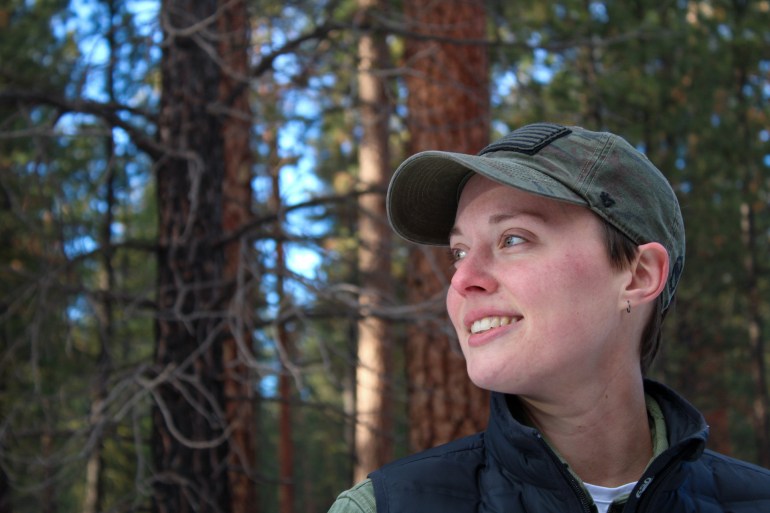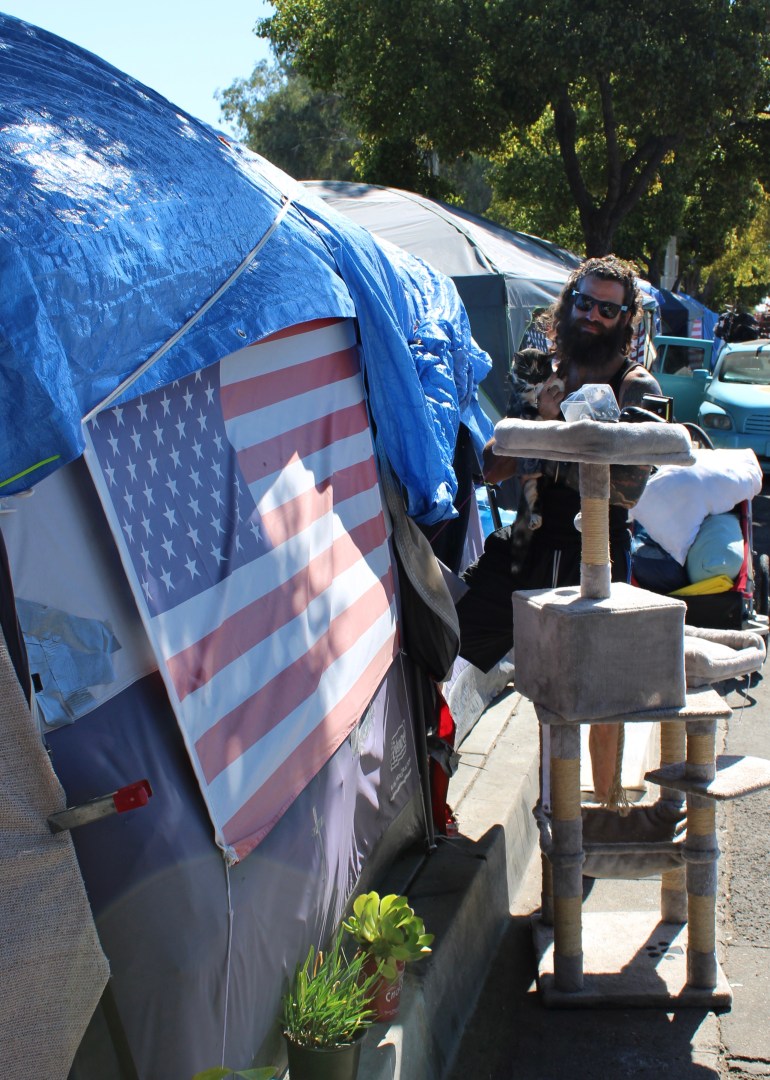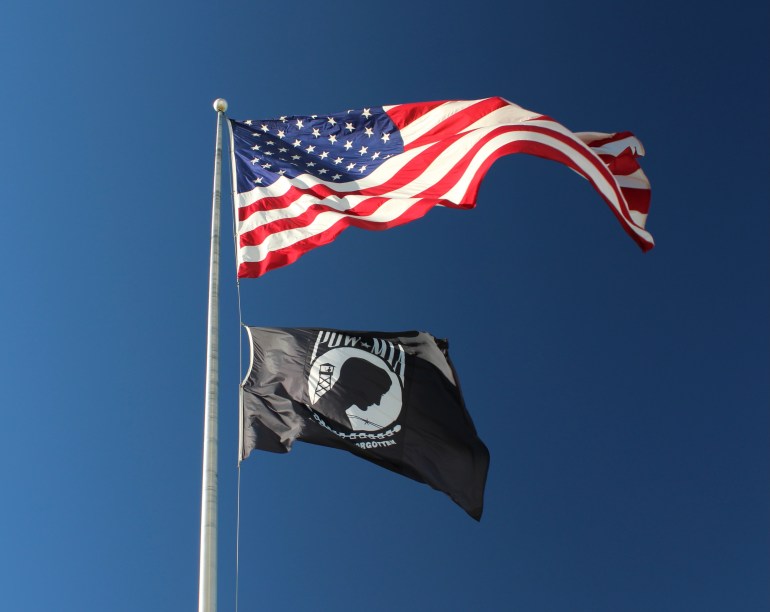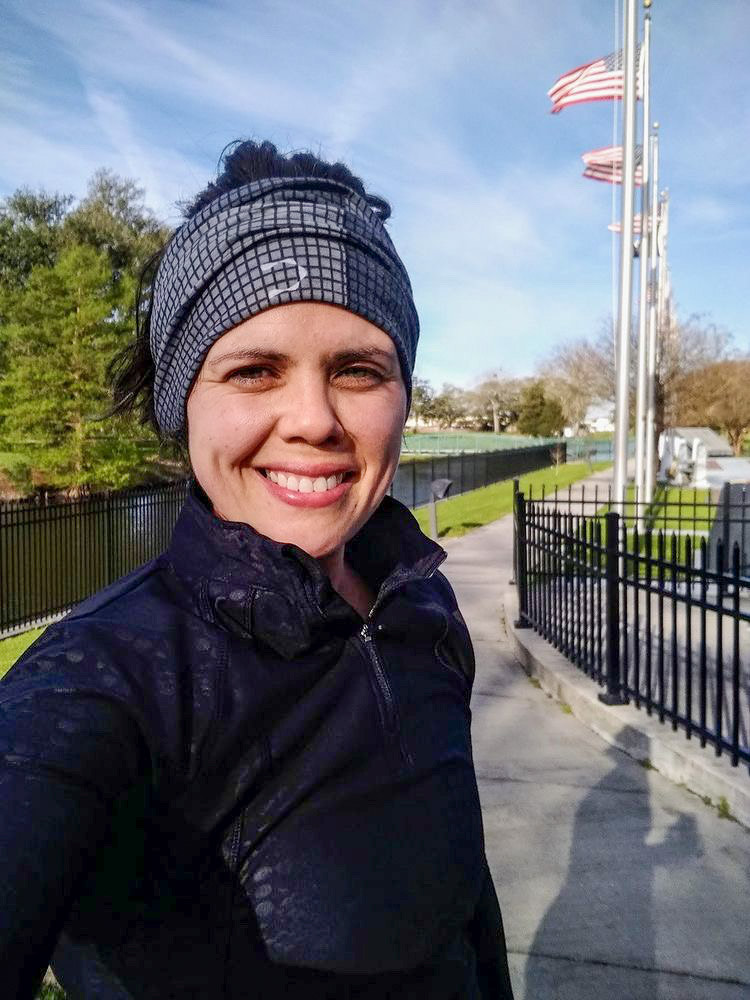What does patriotism mean to US military veterans?
From Vietnam to Afghanistan and Iraq, veterans reflect on their military service and share stories of racism, sexual assault, PTSD, homelessness and suicide.

I remember September 11, 2001. I was in seventh grade. With tears streaming down my mother’s face, she carefully removed her flag from the shadowbox she had been gifted at her air force retirement ceremony just months earlier. She wondered aloud if she would be recalled to active duty as she hung the flag in the window of our apartment. Partisan implications were the furthest thing from my mother’s mind that day.
Military service is often lauded as the pinnacle of patriotism. “Thank you for your service,” is regurgitated reflexively every time I ask about a military discount. I served six weeks in air force basic training before being declared medically unfit for service but given a disability rating. It does not feel worthy of thanks but no one asks for details, so automatic is the response.
Keep reading
list of 4 itemsBeach widows: War, death and the battles of those left behind
From lynchings to the Capitol: Racism and the violence of revelry
How disabled Americans are harmed by a system meant to help them
And while people tend to conflate nationalism with patriotism – think of large pick-up trucks with American and “Don’t Tread on Me” flags flapping across their beds – I believe if my mother were alive today, she would disagree.
Some of the people who participated in the United States Capitol riot on January 6 were self-proclaimed “patriots”. Ashli Babbitt, a protester fatally shot by police, was an air force veteran. Veterans were also found protesting against the “tyranny” of COVID-19 containment measures and counterprotesting Black Lives Matter events.
Over the past year, a certain stereotype of US military veterans – and their specific conception of “patriotism” – has emerged.
But how do individual veterans reflect on their military service and what does patriotism mean to them?
‘A way to divide people’
I spoke to veterans from all branches of service except the coastguard (and Space Force if we are being technical) encompassing all eras from Vietnam to the present day.

Ryland Young, a 41-year-old navy veteran of the USS Vincennes, who was based in Japan and spent most of his time in the service out at sea in the Pacific and Indian oceans, traced the toxic tinge around American flag symbolism to the presidency of George W Bush. “It was presented as patriotism and as a way to divide people from one another. It was never just trying to rally people around the flag. It was trying to separate the ones who supported Bush from the ones who didn’t.”
Still, in middle school at that time, political complexities such as that were lost on me. I vaguely remember “freedom fries” and a fashion trend that heavily favoured flags.
Ryland explained the implication. “If you didn’t support Bush, then you didn’t support the Iraq war. If you didn’t support the war, then you didn’t support the troops, then you wanted the terrorists to win.”
George Griffith joined the marines as a teenager, desperate to find the purpose for his life. He framed it bluntly, “When Bush-Cheney got elected [in 2000], it started to feel that my fellow marines and I were no longer doing what we were doing – enduring suffering and inflicting suffering – for the sake of defending America.”
It was not the first legitimacy crisis the military faced. Vietnam is now widely regarded as a blight on American history. Infamously, veterans of that war returned to a sharply divided country, were poorly received by the public, and suffered atrocious PTSD that largely went untreated.
When I asked a Vietnam combat veteran of the US Army who preferred to remain anonymous about the meaning of the word patriotism, he could not define it as we both sat waiting for our appointments at the West Los Angeles VA Medical Center. Drafted as a teenager, he said he did what he had to do and that was that. Then, eager to share with someone who wanted to listen, he regaled me with harrowing battle stories – including how he was twice shot down in a helicopter over the jungles of Vietnam but still finished his tour of duty.
Vietnam – during which so many young men were drafted to fight (and die) in a senseless war – sparked public outrage and the abolishment of the draft in 1973 as the anti-war left became increasingly powerful. Surprisingly, the end of conscription was even supported by those on the right as an all-volunteer force aligned with burgeoning neoliberal free-market ideals and pushes towards privatisation.
Conceptions of service and patriotism are likely distinct in an all-volunteer force, I realised after talking with this lonely veteran. His service required no choice or critical thought; he responded to the government’s demands. After chatting with him awhile, I went to my own appointment. Afterwards, I strolled around the massive Veteran Administration campus.
‘Doing the right thing’
The 388-acre (157-hectare) site of the West Los Angeles VA has operated as a veteran’s home in some capacity since the 1800s. In the 1950s, it housed up to 5,000 veterans. Beginning in the 1970s, a rash of privatisation and corporate land leasing fundamentally changed how the federal government operated the site.
In response to COVID-19, the VA reduced the capacity of its housing programme to 50 percent, leaving veterans in tents outside awaiting services. An encampment now lines the outside perimeter of the facility, and inside the fence, nestled mostly out of view of passers-by is an “authorised” encampment, the Care Treatment and Rehabilitation Services (CTRS) programme. It is secured-entry, guarded by two VA security guards who oversee the tents propped up on plywood platforms, the portable showers, and the porta-potties.
Despite having this “authorised” tent city on its grounds, 35 would-be eligible veterans are still relegated to beyond the fence, lining the perimeter of a busy road.
The veterans outside the fence live in tents, have no showers, and occasionally get hit by passing cars. The tents are large, uniform, and set so close together they nearly touch, despite the vast green space just beyond. Each one unironically displays an American flag. It is a jarring sight. They call it Veteran’s Row and it is in the middle of one of the wealthiest neighbourhoods in Los Angeles.
It was there I met Jonathan.

Barely older than me, Jonathan was a sophomore in high school on 9/11. He knew from that moment he was going to enlist in the military, out of a sense of patriotism and duty. He wanted to defend his country and its people. Joining right after high school, he was deployed to Iraq before he was even old enough to legally buy a beer (age 21 in the US). He questioned the pretence under which the US had invaded during his tour of duty with every horror that he witnessed, eventually becoming disillusioned and convinced that the American government had lied. He completed his five-year term of enlistment but, according to him, the American government failed to live up to their end of the bargain. He did not receive the services he needed. He struggled with post-traumatic stress disorder (PTSD) which led him down a path of substance and alcohol use. Now there is just a tent.
“I would rather not be living in a tent,” he confessed. Needless to say, his definition of patriotism has changed.
While at Veteran’s Row, I also met Rob Reynolds, 32, with the non-profit organisation American Veterans (AMVETS) who volunteers there daily. An Iraq war combat veteran who deployed to the infamous Triangle of Death, Rob has a sharp opinion about patriotism in today’s America. “Patriotism is doing the right thing by people – and especially veterans who raise their right hand to defend this country. We didn’t give up on the country when we went to war. I think the best way to honour a service member who has passed away is to take care of a veteran that is still living.”
Homelessness among veterans has long been recognised as a problem. They are at a 50 percent increased risk of becoming homeless over their lifetime. The greatest risk factors are lack of social support and isolation after discharge – re-entering civilian life after years of living in a total institution proves challenging. The issue is compounded by a lack of social services, fractured service delivery, PTSD, and the US’s weak social safety net.
Rob drove the point home, “California has more homeless veterans than any other US state by a wide margin. At least half of all the houseless people around the West LA VA are veterans. Yet there’s only 54 units of permanent housing on the campus today.”
He repeatedly cites improper land use, privatisation, and poor governance verging on corruption as the root causes of this massive housing disparity.

‘My block, my community’
Problems facing the living are not limited to housing. Veterans are at an enormously increased risk of suicide. The scars of war are not always visible. Healing the psyche – and therefore preventing suicide – is 39-year-old Marine Corps veteran Wyly Gray’s goal. As his organisation operates just outside of DC, we spoke via telephone. He served from 2000 to 2008 and deployed first in 2003 to a ship in support of the Iraq war and then to the Helmand Valley of Afghanistan in 2008.
At 18, he would have reflexively defined patriotism as “doing something bigger than yourself, protecting your country, and protecting your countrymen”. After enduring war and loss, he redefined not only the word but his mission. By zooming in, he found purpose and a way of giving back.
“Patriotism now means something that I can really control. My block, my community. Where my little eyes and my little hands can physically reach. It means giving back to those veterans that may not be so lucky for whatever reason, due to their own failing support structures or overwhelming trauma to their psyche or their body.”
A close friend of his went from holding a top-secret clearance and working an elite job in the Corps to dying in the depths of despair, homeless, suffering from PTSD. Such a rapid fall from grace cut Wyly deeply. He, too, battles suicidal ideation. The problem is not abstract.
His solution? Supporting veterans in their recovery from PTSD. He runs the nonprofit Veterans of War that offers group therapy and long-term support, assisted by plant medicine.
According to the VA’s own data, veterans commit suicide at a rate 1.5 times higher than the non-veteran population, with the average daily number of suicides increasing steeply since 2005 and now hovering between 17 and 20. The problem has long been recognised but has been resistant to a variety of prevention programmes administered by the VA.
Nearly every veteran I spoke to mentioned losing someone to suicide. In a previous piece I wrote for Al Jazeera, I wrote of a mother’s anguish over her daughter’s suicide, an army veteran of the Iraq war. I have lost at least one friend to post-deployment suicide, not to mention alcohol-involved car wrecks and drug overdoses. Kristen Gonzalez-Soto, a 32-year-old veteran, says in her capacity as a section Sergeant in the Marine Corps she walked into many barracks rooms to find people “hanging from their racks”.
‘The poor-to-military pipeline’
I did not set out to write about suicide or housing. But after talking to a dozen veterans, I realised these topics are inextricably linked to modern military service and the conceptions of patriotism therein.
The first question I asked people was why they joined the military. Most of the white men I interviewed enlisted out of a sense of duty to country, often passed down through their male lineage or spontaneously generated as they watched the Twin Towers fall. Others had less romantic notions of military service.
Ryan Redondo, who is Latino, was houseless for his final two years of high school and joined the army because of a lack of other opportunities. He says he fell prey to the “poor-to-military pipeline”.
“What I liked about the army was the racism was very blatant,” he said without a trace of sarcasm. “Any antiquated racist term you want to call me, I got it from day one.” It was a relief compared with the veiled passive-aggressive racism of Orange County where he grew up, he explained.

Like Ryan, Kye’s life and service were punctuated by racism. After he left high school in Long Beach, California, no employer would accept his applications. He joined the navy because he had to get out of his grandmother’s house, where he had nothing more than a couch in an impoverished neighbourhood plagued with gangs.
He was “undesignated”, a position on a ship that is often tasked with hard labour and odd jobs. “Historically, undesignated shipmen were Black people. And I’m Black.”
Kye says his experience of racism in the navy was that it was often cloaked behind the protocol and coated in pleasantries but smelled of racism all the same. “You’ve already been Black your whole life, you know what to expect.”
His ship deployed to Haiti in the aftermath of the 2010 earthquake. The carnage – seeing Black bodies pulled out of the rubble and an endless stream of the injured being carted onto the hospital ship – inflicted him with lingering PTSD. After getting out in 2013, he was unhoused for years before finally being connected to VA services. “I didn’t know who to call,” he lamented.
Today’s US military is more diverse than ever before. Forty-three percent of service members belong to a racial or ethnic minority, 16 percent of the military are women, and 18 percent of officers are women. Despite that, issues with both racism and how the military responds to racism continue to plague the ranks.
The incredible racial diversity of the US military is obscured by the stereotype of veterans as conservative white men. In fact, the military is not nearly as conservative as most people think. A Military Times poll from this past November’s election showed troops favoured Biden over Trump, though by just a few percentage points and it varied by poll.
‘The rapes just kept happening’
From racial and ideological diversity to the difficulty of defining “patriotism”, one thing is clear: veterans are not a monolith, despite occasionally being portrayed as such.
Nor did I set out to write about sexual assault.
Kristen Gonzalez-Soto said it best. “Veterans don’t all have to look the same. We don’t all have to feel the same way about certain things. You know, when we think about veterans, we think about Trump supporters and gun rights. But we don’t all look like that. Sometimes we look like me.”
Her story illuminates the contradictions of military service, the inklings of which I learned from a young age.
My mom joined the air force in 1980, at a time when it was prohibited to be LGBTQ and serve. She was repeatedly investigated for homosexual conduct and narrowly escaped a dishonourable discharge. A commanding officer once used her orientation to sexually assault her, she confided to me before her death.
As a child, I remember the contradiction of having to hide the fact I had two moms but only around certain company – my mom’s uniformed coworkers. For the sake of service to her country, she lived an exhausting double life. Despite periodic investigations into her sex life and an isolated assault, she made a career out of the air force. I know the military cannot be reduced to simplistic terms of “good” or “bad”.
But Kristen’s experience pushes my ability to not reduce the military to negative labels to its limits. Houseless, she joined the Marine Corps in 2009. As for what she actually did in the Corps she summarised it: work is work.
But the military is more than just a job.
“What stuck out to me for the military was the way I was underappreciated as a woman. The way that my value lowered, the way it made me feel about myself. That I felt less than. I was sexually assaulted.”
Sexual assault is a pervasive problem in the military (PDF). Egregious scandals such as Vanessa Guillen’s murder last year occasionally push it into the national conversation. The mishandling of her disappearance and murder at Fort Hood army base highlighted systemic issues around the reporting of sexual harassment and assault in the army. In a report that followed the death investigation, army investigators found “major flaws” at Fort Hood and identified a “culture that was permissive of sexual harassment and assault”. Fourteen officials were disciplined.
Systemic and cultural issues are limited to neither Fort Hood nor the army. They have been identified across all branches but little has changed. Cases are infamous for being mishandled and victims traumatised repeatedly. Most assaults go unreported. While a bitterly low 40 percent of women military service members report their rapes, the numbers for men are even lower at 10 percent.
Women are far more likely to be sexually assaulted during their service but it does happen to men too, which is even less discussed. My friend Monty was gang-raped by other soldiers on an army base. Afterwards, he suffered behavioural problems, started drinking excessively, and went absent without leave. He self-medicated for his trauma and shame. The VA finally recognised his disciplinary issues as secondary to his sexual assault – which took him years to report – and he would have been compensated by the VA had he not died of a drug overdose just before his compensation and pension hearing in 2018.
Undeterred if not unscathed, Kristen pushed on. “I thought, you know what? I’m going to do it. I’m going to make a career out of this. But the assaults just kept happening. The rapes just kept happening.”
Disaffected, she left the service after her enlistment term. The country she had sworn to defend with her life failed to defend her. For her, the sight of the American flag now provokes conflicting emotions. Her concept of patriotism warped and withered but is now rebounding.
“I’m finding myself prouder of my military experience. I know what it means for me and what it did for me. I’m not proud of what I had to endure.”
She recounted a story of running around a veteran memorial park at a lake in her town in Louisiana. It displays several large flags, as is common in veteran memorials, which are themselves common throughout the country. One day while on a run, the beauty of the flags struck her. She stopped to take a picture. She intended to post it to social media with a caption about what America and her military service mean to her, but she deleted it. “Who am I kidding?” But when asked to include a photo for this article, that was the exact photo she chose.

When pressed on her contradictory feelings surrounding the American flag, she said, “I have to be super proud of what it means to me and what I would like to see it represent.” She wants the flag to represent peace and unity. She wants it to be a reminder that we the people are allowed, even obligated, to hold the government accountable when it is operating outside of its agreements between its citizens and itself.
She actively works to create that America. Having earned her master’s in public health, she works as a harm reduction outreach coordinator. She serves marginalised people, including people who use drugs, sex workers, and unhoused people in her conservative southwestern Louisiana town. She focuses on HIV and STI prevention, detection, and treatment; overdose prevention; recovery support services; and overall improving the health and quality of life of her community’s least privileged people, the ones who fell through America’s cracks.
‘Why were we there?’
Many veterans’ practice of patriotism is antithetical to the ostentatious displays I have come to loathe. The display is not the same as practice, however we define it.
How we define it depends on our experiences. From why we joined to what we endured during and after service, many factors influence our perspective. People represented their military service in myriad ways, none of which was unequivocally good or bad. Like all things in life, complexity reigns supreme.
In a country that touts such untarnished respect for the military and its veterans, we often fail to meet their needs.
Veterans are the only group of Americans where there is a widely accepted belief that they are deserving of a social safety net, housing, and healthcare. From the far left to the far right, there is broad agreement among the strange bedfellows working in veterans outreach: we are failing to protect those who swore to protect us. The US fails to provide even its most revered subset of the population with an adequate social safety net, so entrenched is the resistance.
To me, patriotism is service to society. It is creating the America that America purports to be. But that is just me – there is no right or wrong answer.
While a single definition for patriotism remains elusive, what is universal is that people want to decide for themselves. No one wants one particular narrative – no matter how dominant – to be rammed down their throats.
Veterans are an incredibly diverse group in all meanings of the word. We decide what military service means to us. We decide how to practise patriotism. We love America how we see fit.
I will no longer allow the American flag to be commandeered by a minority of people to be manipulated for political aims. I will not allow the word “veteran” to become synonymous with any particular political agenda. While the flag evokes distinct emotions in each of us, one thing is certain: it is our flag, too. It represents all Americans, including those with whom you disagree. Cheap attempts at hijacking it to serve narrow political aims violate the very principles for which it stands.
But, as Ryan Redondo achingly pointed out, modern military service is complex and often painful. The legitimacy and necessity of American wars have been cast into doubt, he felt upon his return from Iraq.
“I got a peek into how a lot of Vietnam veterans must have felt. With how that war occurred, when we exited operations and called it a loss after so much carnage, both of the Vietnamese and military service members … And for what? ‘Why were we there? What did that accomplish?’ And they ask themselves that for years. In Iraq, I ask myself if we did any good at all. The government we had supported fell the moment we left. Why put us through that trauma then? Anything more than one civilian death is unacceptable – and thousands died, both directly and indirectly. And for what?”
He, too, will be asking himself that for years to come.
Partisan divides have fractured our country and the American flag is on the vanguard. Meanwhile, people uncritically wave the American flag as the pinnacle of patriotism and thank veterans for their service, even when that service makes many veterans feel conflicted.
I long for the American flag I once knew, the one that perhaps never existed. The one that represented unity. I ache for the patriotism of my mother, the humble service to one’s country for the society contained within it. We must reclaim the narrative around patriotism and military service if we are to create the nation we wish the flag represented.